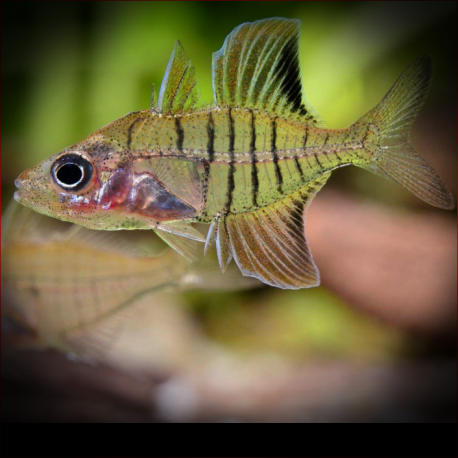More info
Datasheet
| Minimum Tank Size | 60 litres / 15.85 US gallons |
| Maximum Size | 2.6cm / 1.02inches |
| Temperature | 20°C / 68.00°F - 28°C / 82.40°F |
| Hardness | 1.01dgH / 18ppm - 5.04dgH / 90ppm |
| pH | 4.0-6.0 |
General Description
Gymnochanda Verae, a species under the Ambassidae family, is characterized by its delicate nature and translucent, scale-less body. Males exhibit elongated dorsal and anal fin rays, along with red pigmentation in their unpaired fins. On the other hand, females lack extended fin spines and are mostly colorless. With a maximum size of 2.6 cm, this small ambassid features distinctive modified fin characteristics in mature males.
Aquarium Setup
For a suitable tank environment for Gymnochanda Verae, a densely-planted setup with floating vegetation, roots, twigs, and natural leaf litter is recommended. Strong filtration should be avoided, with an air-powered sponge-type unit being ideal. The species requires soft, acidic water with a pH range of 4.0-6.0 and a temperature between 20-28°C. A minimum tank size of 60 liters is necessary, and natural peat should not be used due to environmental concerns.
Behaviour
Gymnochanda Verae is gregarious by nature, and it is advised to keep them in a group of 8-10 specimens at a minimum. Due to their behavior, they are best suited for a species-specific tank or alongside comparably-sized, peaceful species such as Boraras, Sundadanio, or Indostomus spp. They may not thrive in a community tank setting and prefer a harmonious environment.
Feeding and Diet
This species predominantly feeds on small live foods like Artemia and Daphnia, especially during the acclimatization period. Over time, they may accept frozen and dried alternatives. Ensuring a varied diet is crucial for their health and well-being. Gymnochanda Verae's diet should be rich in protein and suitable for their small size and delicate nature.
Reproduction & Dimorphism
Details regarding the reproduction of Gymnochanda Verae are currently unrecorded. Sexual dimorphism is prominent in this species, with males developing extended dorsal and anal fin spines and showcasing red pigmentation in their unpaired fins. In contrast, females lack these traits and are generally devoid of coloration, highlighting distinct differences between the genders.
Habitat and Distribution
Although the specific habitat of Gymnochanda Verae is unconfirmed, its congeners are typically found in low-altitude, swampy freshwater environments. These habitats often feature still or slowly moving acidic water with silt and peat substrates. The distribution of this species is primarily centered around Belitung Island in Indonesia, with no additional populations currently noted. Gymnochanda Verae's natural habitat provides insights into its environmental preferences and requirements.

